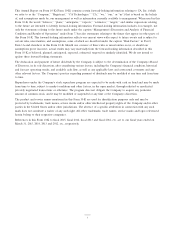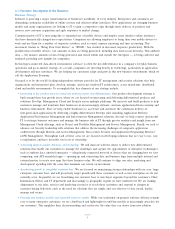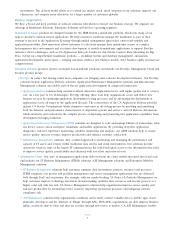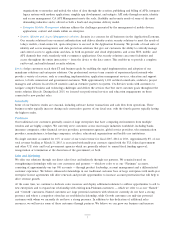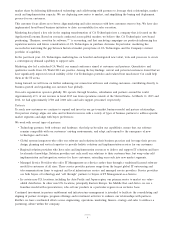Computer Associates 2015 Annual Report Download - page 16
Download and view the complete annual report
Please find page 16 of the 2015 Computer Associates annual report below. You can navigate through the pages in the report by either clicking on the pages listed below, or by using the keyword search tool below to find specific information within the annual report.
or solution sets, we will have invested substantial resources without realizing adequate revenues in return, which could
materially adversely affect our business, financial condition, operating results and cash flow.
We are subject to intense competition in product and service offerings and pricing, and we expect to face
increased competition in the future, which could either diminish demand for or inhibit growth of our products
and, therefore, reduce our sales, revenue and market presence.
The markets for our products are intensely competitive, and we expect product and service offerings and pricing
competition to increase. Some of our competitors have longer operating histories, greater name recognition, a larger
installed base of customers in any particular market niche, larger technical staffs, established relationships with hardware
vendors, or greater financial, technical and marketing resources. Furthermore, our business strategy is predicated upon our
ability to develop and acquire products and services that address customer needs and are accepted by the market better
than those of our competitors.
We also face competition from numerous smaller companies that specialize in specific aspects of the highly fragmented
software industry, and from shareware authors that may develop competing products. In addition, new companies enter the
market on a frequent and regular basis, offering products that compete with those offered by us. Moreover, certain
customers historically have developed their own products that compete with those offered by us. The competition may affect
our ability to attract and retain the technical skills needed to provide services to our customers, forcing us to become more
reliant on delivery of services through third parties. This, in turn, could increase operating costs and decrease our revenue,
profitability and cash flow. Additionally, competition from any of these sources could result in price reductions or
displacement of our products, which could materially adversely affect our business, financial condition, operating results and
cash flow.
Our competitors include large vendors of hardware and operating system software and service providers. The widespread
inclusion of products that perform the same or similar functions as our products bundled within computer hardware or
other companies’ software products, or services similar to those provided by us, could reduce the perceived need for our
products and services, or render our products obsolete and unmarketable. Furthermore, even if these incorporated products
are inferior or more limited than our products, customers may elect to accept the incorporated products rather than
purchasing our products. In addition, the software industry is currently undergoing consolidation as software companies seek
to offer more extensive suites and broader arrays of software products and services, as well as integrated software and
hardware solutions. This consolidation may adversely affect our competitive position, which could materially adversely affect
our business, financial condition, operating results and cash flow. Refer to Part I, Item 1, ‘‘Business — (c) Narrative
Description of the Business — Competition,’’ for additional information.
If our products do not remain compatible with ever-changing operating environments, platforms, or third party
products, we could lose customers and the demand for our products and services could decrease, which could
materially adversely affect our business, financial condition, operating results and cash flow.
The largest suppliers of systems and computing software are, in most cases, the manufacturers of the computer hardware
systems used by most of our customers. Historically, these companies have from time to time modified or introduced new
operating systems, systems software and computer hardware. In the future, new products from these companies could
incorporate features that perform functions currently performed by our products, or could require substantial modification
of our products to maintain compatibility with these companies’ hardware or software. Recently, many established enterprise
hardware vendors have begun to bundle basic management functionality software with their hardware offerings, putting
additional competitive pressures on independent management software vendors like us. Although we have to date been able
to adapt our products and our business to changes introduced by hardware manufacturers and system software developers,
there can be no assurance that we will be able to do so in the future. Failure to deliver distinctive management
functionality, beyond the basic functionality now being bundled by many hardware vendors, that delivers significant and
differentiating value to customers could materially adversely affect our business, financial condition, operating results and
cash flow.
Further, since our solutions interact with a variety of software and hardware developed by third parties, we may lose access
to third-party code and specifications for the development of code, which could materially adversely affect our ability to
develop software compatible with third-party software products in the future. Some software providers and hardware
manufacturers, including some of the largest vendors, have a policy of restricting the use or availability of their code or
technical documentation for some of their operating systems, applications, or hardware. To date, this policy has not had a
13


